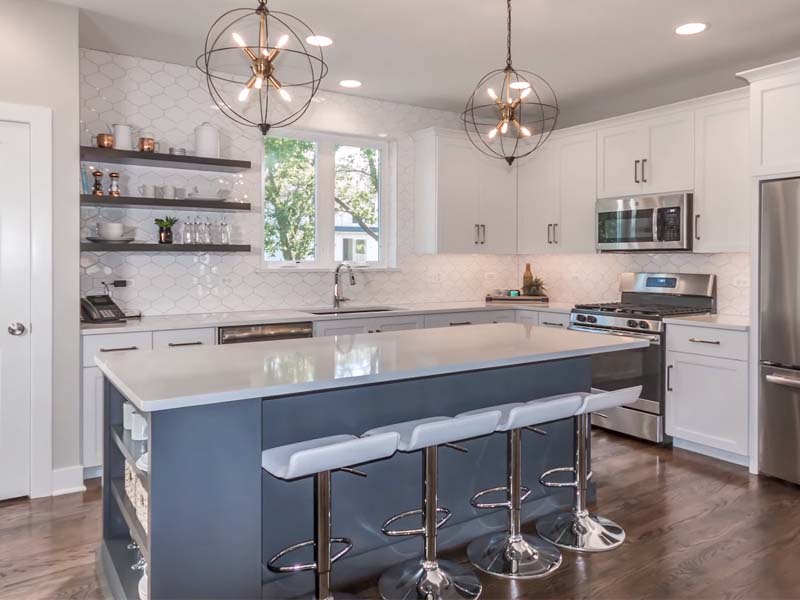How do I design my own kitchen layout?
A well-designed kitchen layout is essential for creating a functional and enjoyable space in your home. By designing your own kitchen layout, you have the opportunity to customize it according to your specific needs and preferences. In this step-by-step guide, we will walk you through the process of designing your own kitchen layout, helping you create a space that is both practical and aesthetically pleasing.
Assessing Your Needs and Preferences
To begin, take some time to assess your cooking habits, lifestyle, and specific requirements. Consider factors such as the number of people using the kitchen, the frequency of cooking, and any unique needs or priorities you may have. This evaluation will serve as the foundation for your design decisions, ensuring that the layout caters to your individual needs.
Gathering Inspiration and Ideas
Next, immerse yourself in kitchen design trends and styles to gather inspiration. Look for ideas in magazines, online platforms, and home improvement shows. Create a mood board or design collage to visualize your preferences and the overall look you wish to achieve. This process will help you refine your vision and narrow down your choices.
Taking Measurements and Evaluating Space
Accurate measurements are crucial for designing a functional kitchen layout. Measure the dimensions of your kitchen area, including walls, windows, doors, and ceiling height. Take note of existing infrastructure and utilities such as plumbing and electrical outlets. Consider any structural limitations or constraints that may affect your design options.
Planning the Work Triangle
The work triangle is a fundamental principle in kitchen design. It involves positioning the sink, stove, and refrigerator in a triangular formation to optimize workflow and minimize unnecessary movement. Consider the relationship between these key elements and ensure that they are conveniently located within the kitchen space.
Allocating Zones and Functions
Identify different functional areas within the kitchen and allocate zones accordingly. Create separate areas for food preparation, cooking, and storage. Depending on your needs, you may also want to include a dining or seating space within the kitchen. Carefully consider the flow between these zones to ensure efficiency and convenience.
Selecting Cabinetry and Appliances
Choose the right type and style of kitchen cabinets that align with your design vision and storage needs. Consider the material, color, and finish of the cabinets. Select appliances that suit your cooking requirements and budget. Ensure proper integration and placement of appliances within the layout for optimal functionality.
These days, a hydroponic system is a must-have in every kitchen. With it, you can have fresh vegetables at your fingertips at all times. Be sure to check out this selection of hydroponic systems.
Designing the Layout
Using the measurements and information gathered, sketch a rough floor plan of your kitchen. Experiment with different layout options, considering factors such as the work triangle, zones, and the overall flow of the space. Strive for a balance between functionality and aesthetics. Finalize the most practical and visually appealing layout that meets your needs.
Considering Storage Solutions
Evaluate your storage needs for utensils, cookware, and pantry items. Incorporate efficient storage solutions such as cabinets, drawers, and shelves. Maximize vertical space and utilize corners effectively to make the most of your kitchen’s storage capacity. Consider incorporating specialized organizers to enhance organization and accessibility.
Lighting and Electrical Considerations
Determine the lighting requirements for different areas of your kitchen. Consider a mix of ambient, task, and accent lighting to create a well-lit and inviting space. Plan the placement of electrical outlets and switches strategically to ensure convenience and accessibility for appliances and devices.
Material Selection and Finishes
Choose suitable materials for countertops, backsplashes, and flooring that align with your design preferences, durability, and maintenance requirements. Consider the aesthetic appeal and cohesion with the overall design scheme of your kitchen. Ensure that the chosen materials are functional and complement your chosen cabinetry and appliances.
Seeking Professional Advice
If needed, consult with kitchen designers or architects to seek their expertise and advice. They can provide insights and recommendations based on their experience and knowledge. Additionally, consider consulting contractors or experienced professionals who can offer valuable input and guidance throughout the design process.
Finalizing the Design
Create a detailed floor plan and elevation drawings to visualize the final design. Review the layout for functionality, aesthetics, and adherence to your needs. Make any necessary adjustments or refinements to optimize the design further. Ensure that the final design reflects your vision and meets your expectations.
Implementing the Design
Once you have finalized the design, it’s time to implement it. Decide whether you will hire professionals or take a DIY approach based on your capabilities and comfort level. If required, obtain the necessary permits and approvals before starting any construction work. Oversee the construction process to ensure that the design is executed as planned.
Conclusion
Designing your own kitchen layout is an exciting and rewarding endeavor. By following this step-by-step guide, you can create a personalized and functional kitchen space that caters to your unique needs and preferences.
Remember to adapt and maintain the layout as needed, allowing your kitchen to evolve with your changing requirements. Enjoy the satisfaction of a well-designed kitchen that enhances your culinary experience and brings joy to your home.
